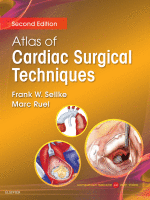Physical Address
304 North Cardinal St.
Dorchester Center, MA 02124

◆ In 1968, Bentall and De Bono described a technique for composite aortic valve and root replacement with reimplantation of the coronary arteries. The coronary arteries were sewn to the graft as a side-to-side anastomosis, and the aneurysm wall was…

Step 1 Surgical Anatomy of the Aortic Root ◆ The aortic root is the anatomic segment between the left ventricle and ascending aorta. From the surgical viewpoint, it consists of the aortic annulus (AA), aortic cusps, aortic sinuses, and sinotubular…

Step 1 Introductory Considerations ◆ Aortic valve repair (AVr) has been shown to have a lower rate of valve-related complications compared to aortic valve replacement (AVR). ◆ It is especially beneficial for those in the younger age group due to…

Introduction ◆ Aortic valve replacement (AVR) is one of the most commonly performed operations in cardiac surgery. It is not only effective in alleviating symptoms in patients suffering from aortic valve disease, but also improves survival. However, in patients with…

Step 1 Introductory Considerations ◆ Minimally invasive valve surgery has numerous benefits compared with a standard median sternotomy. These benefits include reduced surgical trauma, blood loss, transfusion requirements, and reoperations for bleeding. Ventilation times and intensive care unit and hospital…

Introductory Considerations Step 1 Surgical Anatomy ◆ The aortic valve is the last valve in the heart through which the blood is pumped before it goes to the body. The purpose of the aortic valve is to prevent backflow of…

Step 1 Surgical Anatomy ◆ Postinfarction ventricular septal defects (VSDs) are classified as occurring in three locations—apical, anterior, and posteroinferior ( Fig. 8.1 ). Most common is an anterior or apical defect caused by anterior septal myocardial infarction after occlusion…

Introductory Considerations ◆ The goal of any minimally invasive procedure is to achieve the least surgical trauma possible and to carry out the intervention in a port-only approach. After unsuccessful attempts to perform endoscopic coronary bypass surgery using long-shafted thoracoscopic…

Definition and Rationale ◆ Hybrid coronary revascularization (HCR) is defined as the combination of coronary artery bypass grafting (CABG) and percutaneous coronary intervention (PCI) to treat multivessel coronary artery disease (CAD). HCR most commonly combines a minimally invasive CABG procedure…

See Videos 5.1 to 5.10 on ExpertConsult.com . Minimally Invasive Cardiac Surgery–Coronary Artery Bypass Grafting (MICS CABG) ◆ This technique enables revascularization with a similar configuration as that in a sternotomy technique, using left internal thoracic artery (LITA) harvesting and…